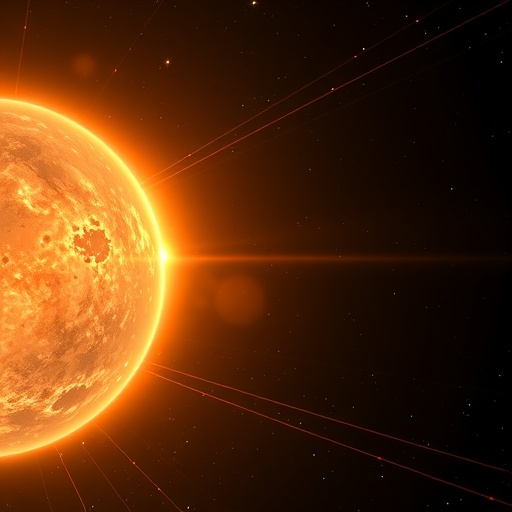In a groundbreaking discovery that pushes the boundaries of our understanding of chemical composition beyond the Solar System, astronomers utilizing the advanced capabilities of the James Webb Space Telescope (JWST) have identified the presence of the molecule phosphine (PH₃) within the atmosphere of the cold brown dwarf Wolf 1130C. This finding, detailed in a recent study published in the prestigious journal Science, challenges prior assumptions about the scarcity of phosphine in such substellar objects and reveals intriguing complexities in low-temperature atmospheric chemistry.
Phosphine, a compound composed of phosphorus and hydrogen, has long been recognized as a key molecule in planetary atmospheres closer to Earth. Its presence has been confirmed in gas giants like Jupiter and Saturn within our own Solar System, where it exists as a significant chemical constituent. Its detection beyond these familiar environments, however, has remained elusive and speculative, particularly within the atmospheres of distant exoplanets and brown dwarfs — celestial bodies that blur the distinction between giant planets and the smallest stars.
The detection of phosphine beyond the Solar System, especially in the atmosphere of Wolf 1130C, marks a significant milestone. Brown dwarfs such as Wolf 1130C are often characterized by their low temperatures and metal-poor compositions, factors which theoretically influence the formation and destruction of various molecular species. Previous observational campaigns using ground-based and space telescopes had failed to detect phosphine at significant levels in similar objects, leading to the belief that phosphine’s abundance might be negligible or non-existent outside the gas giant exoplanets.
The research team, led by Adam Burgasser, harnessed the extraordinary sensitivity and spectral resolution of JWST’s NIRSpec instrument to perform an unprecedented high-resolution spectroscopic survey of Wolf 1130C’s atmosphere. The results revealed multiple distinct absorption features attributable to phosphine, offering an unambiguous signature of this molecule’s presence. Quantitatively, the abundance was determined to be approximately 0.100 ± 0.009 parts per million— a concentration remarkably akin to that found in Jupiter and Saturn’s atmospheres, and vastly greater than the upper limits previously established for other brown dwarfs and exoplanets.
This discovery is not only remarkable for the detection itself but also for the implications it holds on atmospheric dynamics and chemical pathways in substellar objects. Through detailed modeling efforts, the authors propose that reproducing the observed phosphine abundance requires invoking vigorous vertical mixing processes. Such mixing would transport phosphine from deeper atmospheric layers — where it may be produced or preserved — to the observable upper atmosphere. This mechanism also aligns with the brown dwarf’s low metallicity, meaning fewer elements heavier than helium, which influences the overall chemical equilibrium and reaction kinetics within the atmosphere.
The presence of phosphine in Wolf 1130C thereby serves as both a tracer of atmospheric physics and a diagnostic tool for understanding complex phosphorus chemistry under low temperature regimes. Phosphorus-bearing species exhibit a rich and intricate chemical network, yet our comprehension of their behavior outside the Solar System remains incomplete. The study underscores how these newly acquired observations expose gaps in current atmospheric models, emphasizing the necessity for refined chemical schemes and enhanced understanding of non-equilibrium processes.
Notably, the identification of phosphine in a cold brown dwarf atmosphere also demands a reconsideration of its role as a potential biosignature gas. Phosphine has been proposed as an indicator of biological activity, particularly on planets with reducing atmospheres where abiotic production mechanisms are inefficient or absent. However, the significant natural presence of phosphine in Wolf 1130C’s atmosphere—an environment devoid of life as we know it—highlights the complexities inherent in attributing such molecules solely to biological origins.
The findings, therefore, serve as a cautionary tale for researchers involved in exoplanet biosignature detection. Before phosphine can be reliably employed as evidence for extant life on other worlds, the planetary and atmospheric sciences community must resolve the extant discrepancies between model predictions and observational data for phosphorus chemistry. This entails advancing theoretical frameworks that incorporate comprehensive chemical kinetics, vertical transport dynamics, and elemental abundances across diverse planetary atmospheres.
Furthermore, the discovery exemplifies the exceptional capabilities of the James Webb Space Telescope as a tool not just for deep space imaging but also as a powerful spectroscopy platform for probing molecular compositions at vast distances. Its ability to disentangle faint spectral features from cool, dim targets like brown dwarfs opens up a new frontier of detailed chemical characterization that was previously unattainable with older instruments.
The study of Wolf 1130C thus heralds a new era in the exploration of substellar atmospheres and the quest to understand the diversity and complexity of chemical processes beyond our Solar System. The revelation that phosphine is detectable and abundant under such cold and metal-poor conditions invites astronomers to broaden their search parameters and reconsider the chemical richness of similar objects in the galaxy.
In conclusion, the detection of undepleted phosphine in Wolf 1130C’s atmosphere represents a landmark achievement in astrophysical chemistry and observational astronomy. It confronts prevailing theoretical models, refines our approach to neoteric atmospheric science, and recalibrates the frameworks within which biosignatures are interpreted. Upcoming research efforts, fueled by these insights, are poised to unravel further mysteries of phosphorus chemistry and atmospheric dynamics in the cosmos, providing a more nuanced understanding of the conditions that shape planetary and substellar environments.
Subject of Research: Detection and analysis of phosphine (PH₃) in the atmosphere of the cold, metal-poor brown dwarf Wolf 1130C.
Article Title: Observation of undepleted phosphine in the atmosphere of a low-temperature brown dwarf
News Publication Date: 2-Oct-2025
Web References: 10.1126/science.adu0401
References:
Burgasser, A., et al. “Observation of undepleted phosphine in the atmosphere of a low-temperature brown dwarf.” Science, 2025.
Keywords: phosphine, brown dwarf, Wolf 1130C, JWST, NIRSpec, substellar atmospheres, atmospheric chemistry, vertical mixing, biosignatures, phosphorus chemistry, exoplanets, spectral detection




